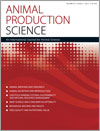
Animal Production Science
Volume 54 Number 5 2014
ANv54n5_EDEvolution of an interdisciplinary and applied journal of the animal sciences
AN13381Interactions between microbial consortia in biofilms: a paradigm shift in rumen microbial ecology and enteric methane mitigation
Worldwide, scientists are researching ways to minimise ruminant emissions of the greenhouse gas, methane. Drawing on research on the rumen and from other anaerobic ecosystems, this essay redefines current views on how microbial consortia dispose of hydrogen produced in biofilms on feed particles in the rumen. Potential methane mitigating feed additives (nitrate, nitro-compounds, chlorinated hydrocarbons, anti-protozoals and charcoal) and their possible effects on the production of methane, formate, acetate and hydrogen gas in the fermenting consortia in and on biofilms are discussed.
AN13381 Abstract | AN13381 Full Text | AN13381PDF (1.1 MB) Open Access Article
AN13129Genomic prediction of weight and wool traits in a multi-breed sheep population
Use of genomic data for estimation of breeding value in rams can considerably increase the accuracy of selection of sheep for increased profitability. In this study we found the accuracy of genomic prediction for weight, muscle, fat and wool traits to be moderate to high in Merinos and moderate in terminal and maternal sheep breeds. These results provide confidence to use genomic selection in sheep breeding.
AN12398Hormonal growth implants affect feed efficiency and expression of residual feed intake-associated genes in beef cattle
Residual feed intake (RFI) is a measure of feed efficiency for genetic improvement in cattle and correlated with feed conversion ratio (FCR). Our study of expression of RFI-associated genes demonstrated that RFI was not affected by increased FCR with hormonal growth implants. The assumed action mechanism of protein turnover by HGP has little effect on RFI and RFI-associated gene expression.
AN12368Comparing AUS-MEAT marbling scores using image analysis traits to estimate genetic parameters for marbling of Japanese Black cattle in Australia
The aim of this study was to evaluate the application of image analysis for Japanese Black cattle in Australia (Australian JB). Image analysis traits showed favourable characteristics for data analysis and indicated possibility of improving for marbling. We conclude that image analysis could be an effective method for improving the marbling of the Australian JB.
AN13069The comparison of two embryo donor breeds for the generation of transgenic goats by DNA pronuclear microinjection
Transgenic goats are usually obtained by DNA microinjection, which is still an inefficient technique but the possibility of detecting differences among embryo donor breeds to improve its success may provide real benefits. Two breeds (Canindé vs Saanen) were compared to produce pronuclear embryos for further microinjection and transfer to recipients. It was possible to develop an efficient protocol to obtain transgenic goats using the Canindé breed.
AN12387A diagnostic method for gander selection in Zi geese (Anser cygnoides L.) and Rhin geese (Anser anser L.) using massage reaction and semen quality
Goose production has been expanding in China, but low reproduction efficiency has limited genetic improvement and production. Identification and culling of subfertile ganders is an effective method to improve production efficiency that has received considerable attention. Here we propose a diagnostic method for gander selection that we feel will be relevant to physiologists, geneticists, poultry breeders and others involved in waterfowl production.
AN12333Utilisation of Large White × Mong Cai crossbred sows and Duroc and stress negative Piétrain boars for the production of fattening pigs under household conditions in northern Vietnam
Pig production contributes up to 41% of the total income of households in North Vietnam. In this experiment, Duroc and stress-negative Piétrain sires were used to produce fattening pigs under household conditions in Vietnam. The results show that use of Piétrain boars does not affect reproduction performance, growth rate, or meat quality; however, lean meat percentage of Piétrain-sired pigs was higher than that of Duroc-sired pigs. This suggests that the use of stress-negative Piétrain boars as terminal sires would improve lean meat under household conditions in North Vietnam.
AN12402Repeatability and frequency of in-paddock sheep walk-over weights: implications for flock-based management
If farmers know the average liveweight of their flocks they may be able to manage their sheep for improved production and profits. This study investigated whether walk-over weighing (WOW), a remote weighing concept, could provide sufficiently reliable flock average liveweight information to aid flock management. Results show that, over a 5-day time period, WOW could reliably provide flock liveweight estimates within 2 kg, which we deem reasonable, in terms of accuracy and timeliness, for application in a commercial context.
AN13108The influence of stocking rate and mixed grazing of Angora goats and Merino sheep on animal and pasture production in southern Australia. 4. Gastrointestinal parasitism
Gastrointestinal nematodes limit the production of goats and sheep but there are few reliable sources of information for recommending management practices across flocks. We aimed to determine the effects of mixed grazing of goats with sheep and increasing the stocking rate of goats and sheep on the level of gastrointestinal parasitism. Mixed grazing with goats resulted in beneficial effects for sheep but mixed grazing with sheep provided beneficial or harmful effects for goats, depending on the stocking rate.
AN13026Nutritive value, in vitro fermentation and methane production of perennial pastures as affected by botanical composition over a growing season in the south of Chile
Perennial ryegrass is the most common species used for grazing dairy systems; however, well managed permanent fertilised pastures may represent a more economical and sustainable alternative. An in vitro trial was carried out in order to assess in vitro fermentation of permanent pastures. Nutrient digestibility, ruminal fermentation products and microbial protein synthesis of well managed permanent pastures were similar to perennial ryegrass.
AN12280Lysine requirement of 1.5–5.5 kg pigs fed liquid diets
Low birthweight pigs tend to have a much lower chance of survival than their larger litter mates due to competition for milk which can lead to starvation. This study determined the lysine requirement of pigs weaned at 1-2 days of age and fed a liquid diet. Definition of nutrient requirements will lead to improved formulation of liquid diets for rearing low birthweight pigs to increase piglet survival and promote rapid growth rate to weaning.
AN12372Effects of dietary probiotics on growth performance, faecal microbiota and serum profiles in weaned piglets
The option of using probiotics as an alternative to antibiotics in raising pigs is receiving attention. The aim of this work was to evaluate the effects of dietary probiotics on weaned piglets and the results suggested that dietary probiotics benefited growth performance and immune functions at the early stage of the post-weaning period in piglets. This could satisfy consumer’s demand for safe feed additives.
AN13073The carcass quality, meat quality and sensory characteristics of broilers raised on diets containing either Musca domestica larvae meal, fish meal or soya bean meal as the main protein source
Presently, the worldwide poultry industry is experiencing difficulties in maintaining production costs, especially pertaining to energy and protein sources.The effects of Musca domestica (common house fly) larvae meal on the meat quality of broiler chickens were investigated. It was concluded that the inclusion of larvae meal into the diets of broilers will have positive rather than any detrimental effects on most carcass, meat and sensory characteristics.
AN13033The impact of best practice health and husbandry interventions on smallholder cattle productivity in southern Cambodia
Food security is of increasing importance in the Greater Mekong Subregion, where smallholder farmers operating mixed farming systems have an opportunity to meet a regional growing demand for red meat. Using a systems and knowledge based approach, cattle health and husbandry interventions led to significant improvements in smallholder cattle production. Improving livestock production offers a pathway to reduce regional food insecurity and rural poverty simultaneously.
AN13032Effects of type, sex and age on goat skin and leather characteristics
Goats are a largely untapped resource for the production of leather, an industry that is important for the economic development of many countries. Determination of skin characteristics which are important in leather production would help to improve quality. The results of this study showed that age and sex were more important than the type of goats on skin and leather traits.



